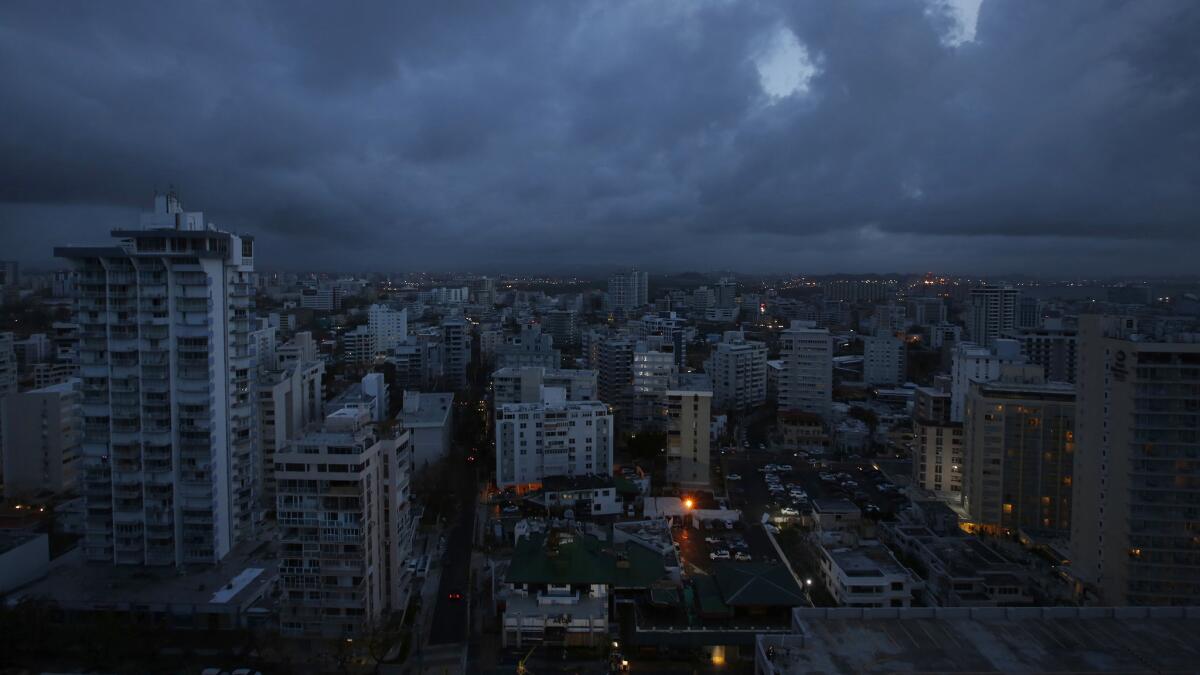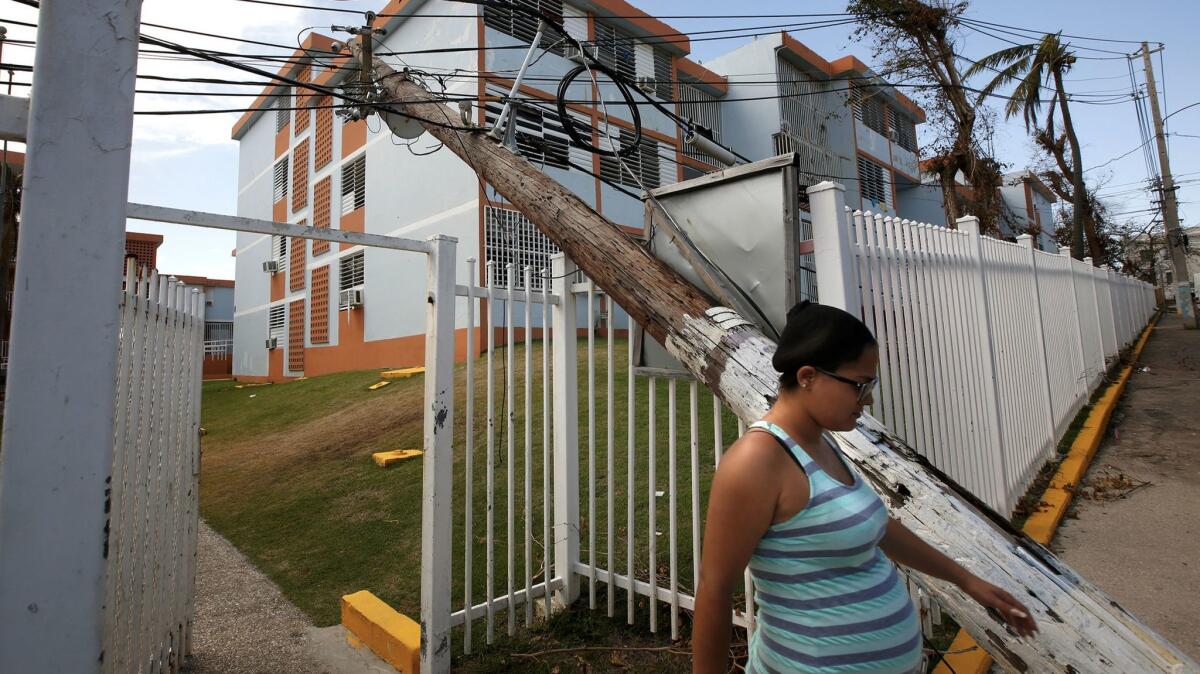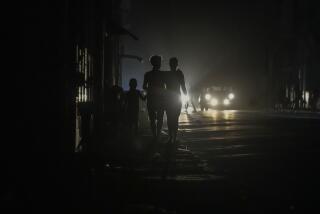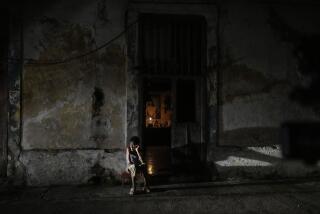Puerto Rico’s debt-plagued power grid was on life support long before hurricanes wiped it out

Reporting from San Juan, Puerto Rico — At a public housing complex just outside the tourist district in Old San Juan, residents must make their way beneath a downed electrical pole to get in the front door. Another broken power pole blocks the road outside, and a third is sprawled next to the parking lot out back.
“At Fortaleza they have light, but not here,” said Rosa Rivera, 53, a retired maintenance worker, referring to the governor’s official residence. Rivera was sitting outside in her wheelchair Thursday to avoid the suffocating heat inside with no air conditioning.
Angel Perez, who lives nearby in the upscale Condado neighborhood, has called the city repeatedly to find out when the power — out across more than 95% of Puerto Rico since Hurricane Maria hit on Sept. 20 — will be restored.
“No one has come,” Perez said. “They don’t pick up the phone.”

Puerto Rico officials say it will likely be four to six months before power is fully restored across the U.S. territory of 3.5 million people. The island’s faltering electrical grid, now crippled by the twin blows of Hurricane Maria and Hurricane Irma, already was struggling to keep the lights on after a history of poor maintenance, poorly trained staff, allegations of corruption and crushing debt.
As recently as 2016, the island suffered a three-day, island-wide blackout as a result of a fire. A private energy consultant noted then that the Puerto Rico Electric Power Authority “appears to be running on fumes, and … desperately requires an infusion of capital — monetary, human and intellectual — to restore a functional utility.”
Puerto Ricans in early 2016 were suffering power outages at rates four to five times higher than average U.S. customers, said the report from the Massachusetts-based Synapse Energy Economics.
And then came Maria.
The collapse of the power system has tumbled down the infrastructure chain, making it difficult to pump water supplies — the water authority is one of the power authority’s biggest clients — and also to operate the cellular phone system, which also relies on the power grid.
Residents have been scrounging for scarce fuel to power generators long enough to keep refrigerators and a light or two running. At night, many drag mattresses out to balconies and porches to escape the heat. Hospitals have seen life support systems fail and most business has come to a halt.
Much of the booming capital has been shrouded in nighttime darkness, except for the few restaurants able to stay open with generators — glowing magnets of cool air, iced drinks and salsa music.
Puerto Rico largely survived Hurricane Irma, which killed three people and led to widespread power outages when it sideswiped the island two weeks ago. In relatively short order, the government-owned PREPA was able to restore electricity to 96% of its 1.5 million customers.
But the ferocious winds of Hurricane Maria a week later took out 55% of the island’s transmission towers. Government officials and emergency responders said the island’s power grid was effectively destroyed.
“Our infrastructure and energy distribution systems suffered great damages,” Puerto Rico Gov. Ricardo Rossello said.
Mike Hyland, senior vice president of engineering for the American Public Power Assn., a nonprofit organization that sent equipment and utility experts to help with recovery, said officials are conducting a comprehensive assessment of damage to the electrical system, relying in part on drones sent by the New York State Department of Environmental Conservation.
“It is going to be a long and arduous process and patience is the key word,” Hyland said.
Restoring Puerto Rico’s power will involve much more than replacing downed poles and cables. The entire system of generation, transmission and distribution must be rebuilt, including replacement of high-voltage transmission lines Hyland said.
The island has been relying on generators large and small, but fuel shortages have limited their capacity.
At least two people died this week in the city of San Juan after the generator producing electricity that powered life support systems ran out of fuel, city officials said.
The lack of power has brought some water pumps to a standstill, and a growing number of homes are running out of clean water.
U.S. military officials, part of a contingent of thousands of extra troops being brought in to help with recovery, are helping expedite fuel deliveries to hospitals.
By midweek, 689 of the 1,000 gas stations on the island were operating, Puerto Rico officials said. Fuel was delivered to at least 200 of those stations on Wednesday, they said.
The warnings about impending electricity problems that were issued even before Hurricane Maria hit stemmed from the island’s long history of power outages and the lack of substantial refurbishing and maintenance.
Hurricane Georges in 1998 left the island without power for three weeks. The tropical storm destroyed 30,000 houses and damaged at least another 60,000.
Last year, the island suffered a massive blackout after a fire broke out at one of the island’s main electricity plants, leaving half of the territory’s residents in the dark.
PREPA at the time said two transmission lines had failed.
While natural disasters have underscored the problems of the island’s electrical system, over the past few years the island’s and the power company’s money problems made the power grid particularly susceptible to crippling damage by storms.
As of 2014 the government-owned company was $9 billion in debt, and in July, it filed for bankruptcy under the provisions set by the Puerto Rico Oversight, Management, and Economic Stability Act, a law signed by President Obama in 2016.
Problems accumulated. Cutbacks in tree pruning left the 16,000 miles of primary power lines spread across the island vulnerable. Inspections, maintenance and repairs were scaled back. Up to 30% of the utility’s employees retired or migrated to the U.S. mainland, analysts said, and the utility had trouble hiring experienced employees to replace them.
The neglect led to massive and chronic failures at the Aguirre and Palo Seco power plants. The three-day blackout in September 2016 underscored how fragile the system was, and that the company was “unable to cope with this first contingency,” the Synapse Energy report said.
This week, for the first time since the storm, electrical crews began appearing not just in the capital, but in neighboring Carolina and Rio Grande. Faced with a tangle of downed poles, lines and transformers on nearly every street, it wasn’t clear how much progress they were making.
Across the island, residents have been waiting in gas lines not so much to drive, but to keep their generators running.
Eduardo Millan, sweating in the the afternoon heat in one such line, said he needed fuel for the generator at his home near the airport.
He uses it sparingly — only at night, and only to run the air conditioning, he said. “I need to sleep.”
Times staff writers Hennessy-Fiske reported from San Juan and Vives from Los Angeles.
Twitter: @mollyhf
For more Southern California news, follow @latvives on Twitter.
UPDATES:
5:30 p.m.: This story was updated with additional details of past power problems.
This story was originally published at 4:40 p.m.
More to Read
Sign up for Essential California
The most important California stories and recommendations in your inbox every morning.
You may occasionally receive promotional content from the Los Angeles Times.












